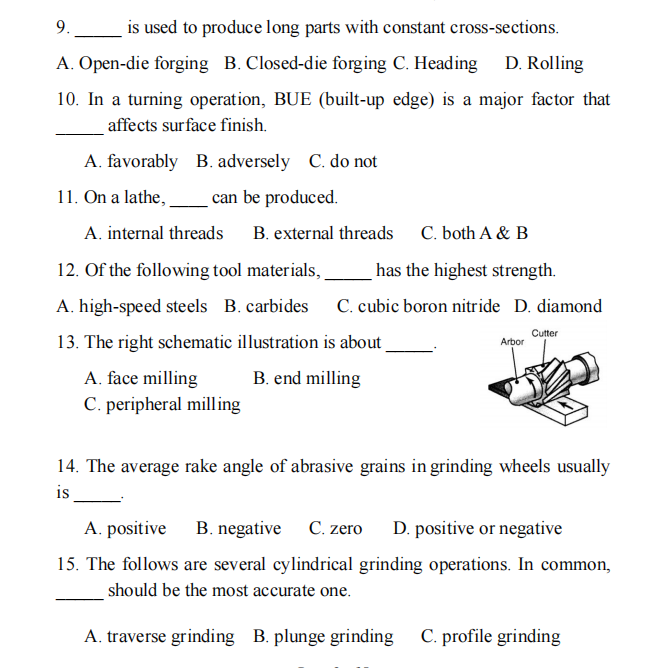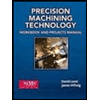ing angle of abrasive grains in grinding wheels ust negative C. zero D. positive or negative several cylindrical grinding operations. In com nost accurate one.
ing angle of abrasive grains in grinding wheels ust negative C. zero D. positive or negative several cylindrical grinding operations. In com nost accurate one.
Precision Machining Technology (MindTap Course List)
2nd Edition
ISBN:9781285444543
Author:Peter J. Hoffman, Eric S. Hopewell, Brian Janes
Publisher:Peter J. Hoffman, Eric S. Hopewell, Brian Janes
Chapter5: Turning
Section5.5: Taper Turning
Problem 14RQ: What are two ways to reduce uneven pressure on lathe centers when using the offset tailstock method?
Related questions
Question

Transcribed Image Text:9.
is used to produce long parts with constant cross-sections.
A. Open-die forging B. Closed-die forging C. Heading D. Rolling
10. In a turning operation, BUE (built-up edge) is a major factor that
affects surface finish.
A. favorably B. adversely C. do not
11. On a lathe,
can be produced.
A. internal threads
B. external threads
C. both A & B
12. Of the following tool materials,
has the highest strength.
A. high-speed steels B. carbides
C. cubic boron nitride D. diamond
Cutter
13. The right schematic illustration is about
Arbor
A. face milling
B. end milling
C. peripheral milling
14. The average rake angle of abrasive grains in grinding wheels usually
is
A. positive B. negative
C. zero
D. positive or negative
15. The follows are several cylindrical grinding operations. In common,
should be the most accurate one.
A. traverse grinding B. plunge grinding C. profile grinding
Expert Solution
This question has been solved!
Explore an expertly crafted, step-by-step solution for a thorough understanding of key concepts.
Step by step
Solved in 2 steps

Knowledge Booster
Learn more about
Need a deep-dive on the concept behind this application? Look no further. Learn more about this topic, mechanical-engineering and related others by exploring similar questions and additional content below.Recommended textbooks for you

Precision Machining Technology (MindTap Course Li…
Mechanical Engineering
ISBN:
9781285444543
Author:
Peter J. Hoffman, Eric S. Hopewell, Brian Janes
Publisher:
Cengage Learning

Precision Machining Technology (MindTap Course Li…
Mechanical Engineering
ISBN:
9781285444543
Author:
Peter J. Hoffman, Eric S. Hopewell, Brian Janes
Publisher:
Cengage Learning